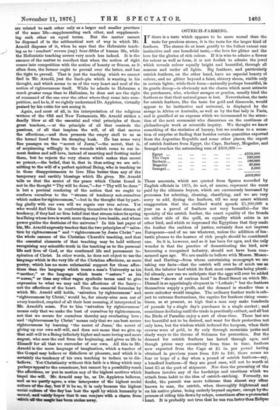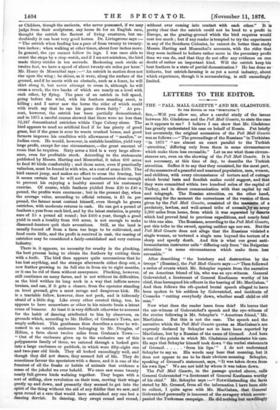OSTRICH-FARMING.
1-there is a taste which appears to be more unreal than the
taste for precious stones, it is the taste for the larger kind of feathers. The stones do at least gratify to the fullest extent one instinctive and one beneficial taste,—the love for glitter and the love for the glories of rich colour. If it is wise to admire a 'flower for colour as well as form, it is not foolish to admire the jewel which reveals colour equally bright and beautiful, through all seasons and under all lights. Big feathers, and particularly ostrich feathers, on the other hand, have no especial beauty of colour, and no glitter beyond a faint, shivery sheen, visible only in certain lights ; while their form—naturally perhaps beautiful, in its gentle droop—is obviously not the charm which most attracts the purchasers, who, whether savages or gentles, usually bind the feathers so that their natural grace is lost. Nevertheless, the taste for ostrich feathers, like the taste for gold and diamonds, would appear to be instinctive and universal, is displayed by the savage in Africa or Australia, as well as by the fine lady in Paris, and is gratified at an expense which we recommend to the atten- tion of the next economist who discourses on the costliness of philanthropic work or scientific inquiry. We thought we knew something of the statistics of luxury, but we confess to a sensa- tion of surprise at finding that besides certain quantities exported from the Argentine Republic and some other places, the export of ostrich feathers from Egypt., the Cape, Barbary, Mogador, and Senegal reaches the astounding sum of £603,000
£250,000 ... The Cape 280,000 Barbary... ••• ... 100;000 ... 20,000 Mogador Senegal... 8,000
X603,000 These amounts, which are quoted from figures recorded by English officials in 1875, do not, of course, represent the sums paid by the ultimate buyers, which are enormously increased by processes for selecting, cleaning, classifying, and we are very sorry to add, dyeing the feathers, till we may assert without exaggeration that the civilised world spends £1,200,000 a year on a parcel of feathers not very beautiful—for the specialty of the ostrich feather, the exact equality of the 'fronds on either side of the quill, an equality which exists in no other bird, and which so impressed the Egyptians that they made the feather the emblem of justice, certainly does not impress Europeans—and of no use whatever, unless the addition of fan- tastic plumes to the hearses of rich people should be considered one. So it is, however, and so it has been for ages, and the only wonder is that the practice of domesticating the bird, now becoming a recognised industry, should not have been com- menced ages ago. We are unable to believe with Messrs. Mogen- thal and Harting—from whose entertaining monograph we are taking our facts—that the ostrich will ever be of much use as food, the inferior beef which its flesh most resembles being plenti- ful already, nor can we anticipate that the eggs will ever be added -to those "shows of curious food" in Bond Street on which Mr. Disraeli is so appetisingly eloquent in " Lothair; " but the feathers themselves supply a profit, and the demand is steadier than a mere onlooker would imagine. The ordinary feather trade is sub- ject to extreme fluctuations, the caprice for feathers rising some- times, as at present, so high that a man may make hundreds of pounds by a single day's purchases in a single market ; and sometimes declining until the trade is practically extinct, and all but the Birds of Paradise enjoy a sort of close-time. These last are too beautiful not to be desired, and want for their protection not only laws, but the wisdom which induced the hoopoes, when their crowns were of gold, to fly only through mountain paths and shady ways to the throne of Solomon for protection. But the demand for ostrich feathers has lasted through ages, and though prices vary excessively from time to time, feathers now exported from the Cape at £5 5s. per pound having obtained in previous years from £20 to £40, there seems no fear or hope of a day when a pound of ostrich feathers—say, a hundred feathers—if they are good ones, will not be worth at least £5 at the port of shipment. Nor does the procuring of the feathers involve any of the hardships and exertions which we attach from habit to the idea of ostrich-catching. Formerly, no doubt, the pursuit was more toilsome than almost any other known to man, the ostrich, when thoroughly frightened and on his native plains, being entirely beyond capture, except by the process of riding him down by relays, sometimes after a protracted hunt. It is probably not true that he can run faster than Eclipse
or Childers, though the ancients, who never possessed, if we may judge from their sculptures, any horse fit for an English race, thought the ostrich the fleetest of living creatures, but un- doubtedly it can beat very good horses. Dr. Livingstone says The ostrich when feeding has a pace of from twenty to twenty- two inches ; when walking at other times, about four inches more.
In general, the eye cannot follow its legs. I was once able to count the steps by a stop-watch, and if I am not mistaken, the bird made thirty strides in ten seconds. Reckoning each stride at twelve feet, we have a speed of about twenty-six miles per hour."
Mr. Henry de Mosenthal says An ostrich in motion does not rise upon the wing ; he skims, as it were, along the surface of the ground, and if he meets with an obstacle, such as a fence, he will skirt along it, but never attempt to cross it, although he will cross a creek, the two banks of which are nearly on a level with each other, by flying. The pace of an ostrich in full speed, going before the wind, with his feathers standing erect, is killing ; and I never saw the horse the rider of which could with truth say that he ran his game down fairly." At pre- sent, however, the ostrich has been partially domesticated, and in 1875 a careful census showed that there were no less than 32,247 domesticated ostriches within Cape Colony alone. The bird appears to need no artificial food if he has plenty of good
grass, but if the grass is sour he wants crushed bones, and good
farmers improve his condition with allowances of " mealies," or Indian corn. He would, however, in suitable localities, yield very large profit, except for one circumstance,—the great amount of room that he requires. Sixty acres a bird is a very large allow- ance, even for profitable stock. According to the statements published by Messrs. Harting and Mosenthal, it takes 600 acres to feed 80 birds comfortably ; and those acres, even if practically valueless, must be fenced in with wire, at a cost of some £500. The bird cannot jump, and makes no effort to cross the fencing, but it seems certain that he will not bear confinement close enough to prevent his enjoying a healthy amount of his customary exercise. Of course, while feathers yielded from £20 to £40 a pound, the profits were enormous ; but in the present day, when the average value, according to official returns, is £5 5s. per pound, the farmer must content himself, even though he grows ostriches, with moderate returns in cash. He can get a pound of feathers a year from each bird, and by the latest statistics, is pretty sure of £5 a pound all round ; but £400 a year, though a good yield in such a locality from 600 acres, is not enough to make diamond-hunters quit their avocations. Still, as the land is usually fenced off from a farm too large to be cultivated, and food costs little, and the profit is received in cash, the rearing of ostriches may be considered a fairly-established and very curious industry.
There is, it appears, no necessity for cruelty in the plucking, the best process being to obtain the feathers by cutting them with a knife. The bird then appears quite unconscious that he has lost anything, and the stumps afterwards either drop out, a new feather growing to its full size in from six to eight months, or it can be rid of them without annoyance. Plucking, however, still continues on many farms, and is not without its difficulties, as the bird writhes its long neck in a way that inflicts severe bruises, and can, if it gets a chance, from the operator standing
on level ground, give a most savage and dangerous kick. He is a tractable fellow, however, does not peck, and is hideously afraid of a little dog. Like every other created thing, too, he appears to have somewhere or other in his minute brain a latent sense of humour. At least it is very difficult otherwise to account for the habit of dancing attributed to him by observers, on grounds which, according to Mr. Heiner, of Graham's Town, are amply suffieient. This gentleman thus describes a scene he wit- nessed in an ostrich enclosure belonging to Mr. Douglas, of Hilton, a farm about twelve miles from Graham's Town :- " Out of the enclosure given up to the exclusive use of this polygamous family of three, we entered through a locked gate into a large enclosure or paddock, in which were fifty-eight one and two-year old birds. They all looked exceedingly well, and though they did not dance, they seemed full of life. They do sometimes favour the spectators with a dance, and it is one of the funniest of all the freaks or habits of animals that evidence a sense of the jokeful we ever beheld. We once saw some twenty nearly full-grown birds waltzing together. They began with a sort of sidling, slow revolution on their toes, moving their wings gently up and down, and presently they seemed to get into the spirit of the thing without the aid of any fiddler that we saw, and spun round at a rate that would have astonished any one but a dancing dervish. In dancing, they swept round and round,
without ever coming into contact with each other." It is pretty clear that the ostrich could not be bred to a profit in Europe, as the grazing-ground which the bird requires would cost too much ; but if any reader is tempted to try the experiment in any of the Southern Colonies, be cannot do. better than study Messrs. Harting and Mosenthal's accounts, with the rider that they seem inclined to believe rather more in the pecuniary profit than we can do, and that they do not offer any evidence on one doubt of rather an important kind. Will the ostrich keep his best feathers in a state of partial domestication ? He has done so hitherto, but ostrich-farming is as yet a novel industry, about which experience, though it is accumulating, is still exceedingly limited.

































 Previous page
Previous page